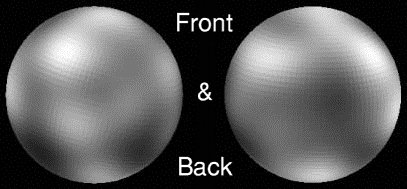
Pluto

Pluto is usually the furthest planet from the Sun, but due to its highly elliptical orbit, it is sometimes closer than the planet Neptune. It is easily the smallest planet, only half the size of Mercury. It is also a rocky planet, unlike it nearest neighbours and due to its extreme distance from the Sun, the surface temperature is only -230 degC. Pluto's surface remained invisible to observors on Earth until mid-1994 when the Hubble Space Telescope (H.S.T.)showed highly-contrasting surface features, including a northern polar cap. These features undoubtedly alter with time as frosts migrate across its surface.
A Lucky Find The method used to find Pluto was the same as that which lead to the discovery of Neptune. Neptune's orbit, like Uranus's, was found to depart slightly from where it should be. Using the Lowell Observatory, in 1931 Clyde Tombaugh (1906-97) found what he was looking for. Although smaller than our Moon, and about a sixth of its mass, Pluto is not the perturbing body that was predicted. This means there could well be a tenth planet.
Controversy! In early 1999, just as Pluto edged its way back to being the furthest planet from the Sun, arguments ignited as to whether it should even be classed a planet.
Companion at the Edge Pluto has one known satellite, Charon, which with a diameter of 1,199km is nearly half the size of Pluto. Charon orbits Pluto at exactly the same speed as Pluto rotates. This tidal coupling means that it 'hangs' stationary in the sky, seemingly motionless.